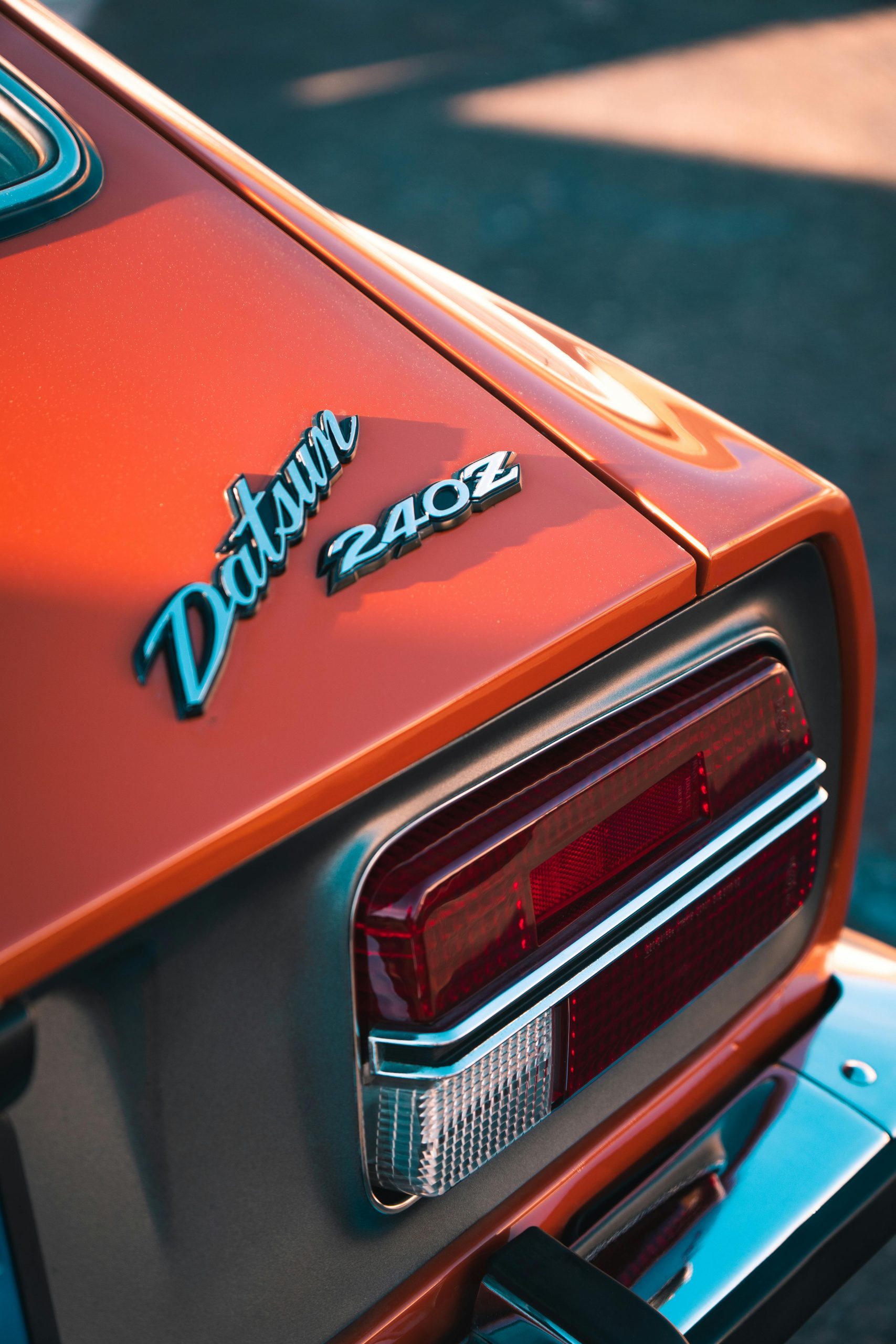1970 Nissan/Datsun 240Z
The Nissan/Datsun 240Z, introduced in 1969 for the 1970 model year, is a classic sports car that transformed the automotive landscape. Known as the Fairlady Z in Japan, the 240Z was sold under the Datsun brand in many markets, including the United States. This car not only established Nissan as a major player in the sports car market but also set the standard for affordable performance vehicles.

The 240Z was the brainchild of Nissan’s design team, led by Yoshihiko Matsuo, whose vision was to create a sports car that combined European styling with Japanese reliability and affordability. The sleek, aerodynamic design featured a long hood, short deck, and a distinctive fastback rear, drawing inspiration from European sports cars like the Jaguar E-Type. This design not only captured the aesthetic desires of the market but also contributed to the car’s aerodynamic efficiency. The front end of the 240Z was characterized by its simple yet aggressive grille, flanked by round headlamps that gave it a purposeful look. The rear end, with its sloping fastback design, provided a sporty profile that distinguished the 240Z from other cars on the road.
Underneath the stylish exterior, the 240Z boasted a robust chassis and a well-tuned suspension system. The front featured a MacPherson strut setup, while the rear utilized a Chapman strut design, providing excellent handling characteristics. This suspension arrangement allowed the 240Z to deliver a smooth ride while maintaining sharp and responsive handling. The car’s lightweight body, made from steel, contributed to its agility and performance. The balance between rigidity and weight reduction was a key factor in the car’s driving dynamics, making it a favorite among driving enthusiasts who appreciated its nimbleness and feedback. The careful engineering extended to the braking system, which included front disc brakes and rear drum brakes, offering reliable stopping power that matched the car’s performance capabilities.
At the heart of the 240Z was the L24 engine, a 2.4-liter inline-six that produced 151 horsepower and 146 lb-ft of torque. This engine, paired with a four-speed manual transmission (a three-speed automatic was also available), allowed the 240Z to achieve impressive acceleration and top speeds for its time. The car could go from 0 to 60 mph in just under 8 seconds, making it a formidable competitor in the sports car market. The engine’s smooth power delivery and robust mid-range torque made it enjoyable to drive both in urban environments and on open roads. The combination of the powerful engine, lightweight design, and well-tuned suspension made the 240Z a joy to drive. It offered a balanced and responsive driving experience that appealed to both casual drivers and enthusiasts alike. The car’s affordability, priced significantly lower than many European sports cars, made it accessible to a broader audience. This accessibility was a crucial factor in the 240Z’s widespread popularity, as it brought sports car ownership within reach of a larger segment of the population.

Manufactured at Nissan’s Shatai Plant in Hiratsuka, Japan, the 240Z saw a production run from 1969 to 1973, with approximately 165,000 units built during this period. This impressive production number is a testament to the car’s popularity and the strong demand it generated across various markets. The production process emphasized quality control and precision, ensuring that each 240Z met the high standards set by Nissan. The 240Z’s success was particularly notable in the United States, where it quickly gained a reputation for its performance, reliability, and stylish design. By offering a high-quality sports car at an affordable price, Nissan tapped into a market demand that had been largely overlooked by other manufacturers. The car’s impact was further amplified by Nissan’s strategic marketing efforts, which highlighted the 240Z’s blend of performance, style, and value.
The main competitors of the 240Z included the Triumph TR6, MGB GT, and the Porsche 914. These European sports cars were well-regarded but often fell short in terms of reliability and affordability when compared to the 240Z. The Triumph TR6, for instance, offered a classic British sports car experience but was plagued by reliability issues and higher maintenance costs. The MGB GT, while stylish and practical, lacked the performance and refinement of the 240Z. The Porsche 914, although innovative with its mid-engine layout, was more expensive and had less power. The 240Z offered a compelling alternative with its combination of performance, style, and Japanese engineering. Its ability to outperform its competitors in key areas like reliability and cost of ownership made it a favorite among sports car buyers.
The success of the 240Z helped establish Nissan as a major player in the global automotive industry. It paved the way for future models in the Z series, including the 260Z, 280Z, and the subsequent generations of the Fairlady Z. The Z series has continued to evolve, with each new model building on the legacy of the original 240Z while incorporating modern technology and performance enhancements. The latest model, the Nissan 400Z, pays homage to its roots with design elements inspired by the 240Z, such as the long hood and fastback profile, while offering cutting-edge features like advanced infotainment systems and high-performance turbocharged engines. This blend of heritage and innovation ensures that the Z series remains relevant and exciting for new generations of sports car enthusiasts.



Today, the Nissan/Datsun 240Z is considered a highly collectible classic car, with values steadily increasing over the years. Well-maintained examples can fetch anywhere from $30,000 to $60,000, depending on the condition, originality, and provenance. Special editions and meticulously restored models can command even higher prices at auctions and among collectors. The 240Z’s enduring popularity is a testament to its timeless design, impressive performance, and the lasting impact it had on the automotive world. Collectors and enthusiasts alike seek out the 240Z for its driving pleasure and its significance as a groundbreaking vehicle that redefined the sports car segment.
The 240Z’s legacy endures as it remains a beloved classic, revered for its groundbreaking design, performance, and the significant impact it had on the sports car market. By setting new standards for affordable performance vehicles, the 240Z not only secured its place in automotive history but also laid the foundation for Nissan’s continued success in the sports car segment. Its influence can be seen in the design and engineering of modern sports cars, and its story continues to inspire a new generation of car enthusiasts who appreciate the blend of style, performance, and value that the 240Z represents.